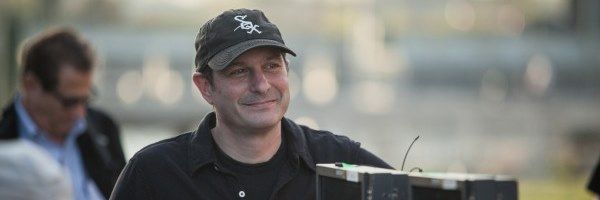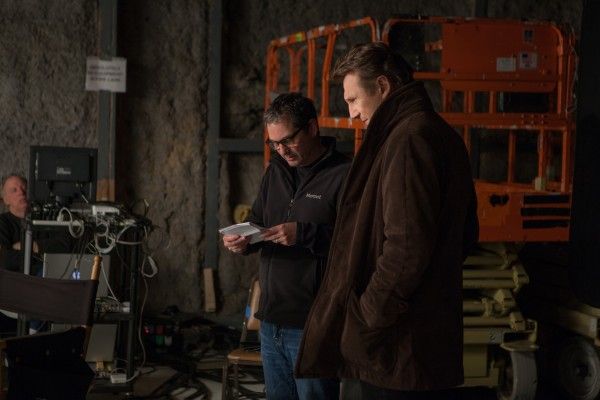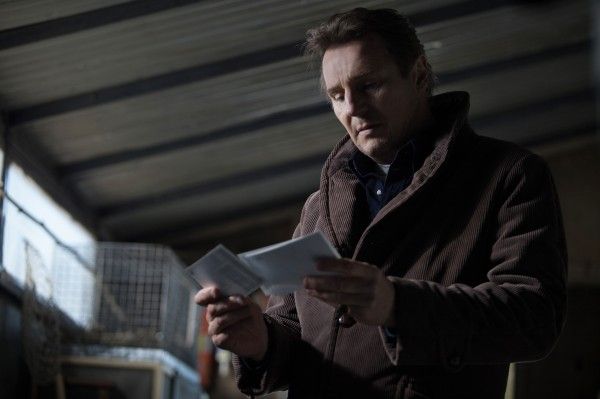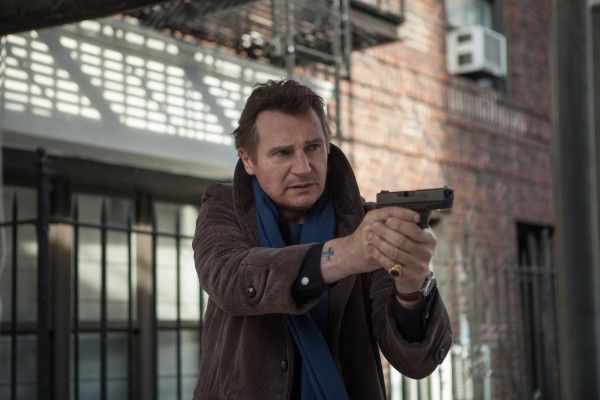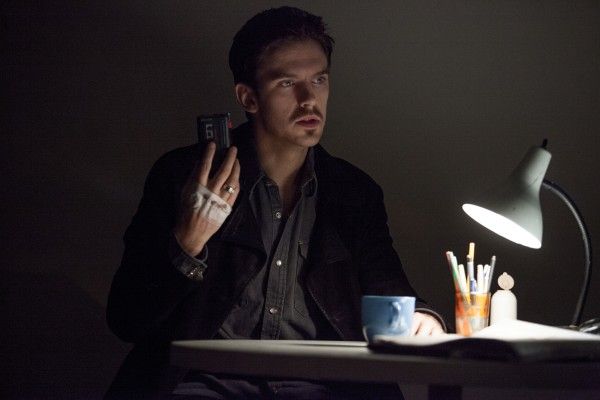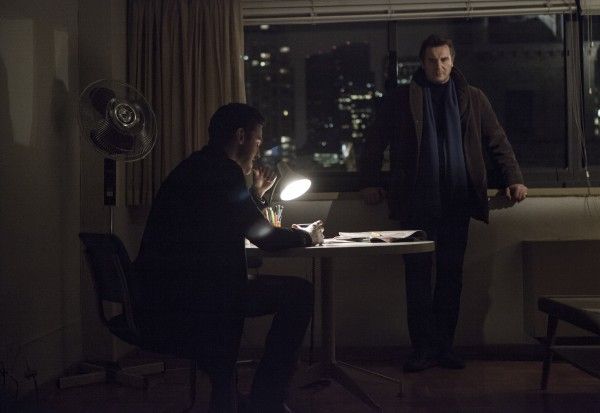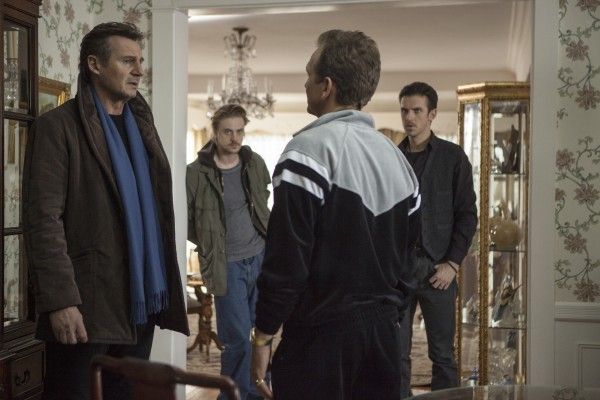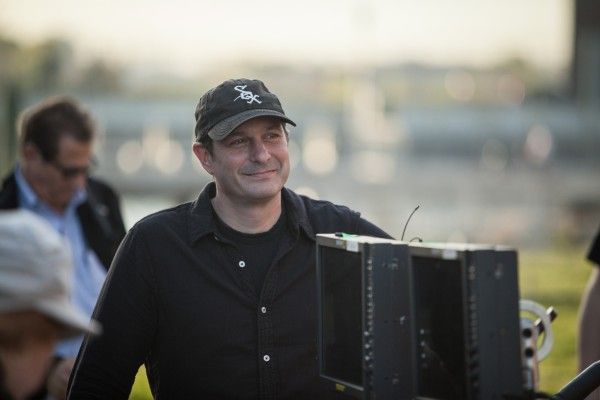After more than a decade in development, writer/director Scott Frank has succeeded in turning best-selling novelist Lawrence Block’s signature book into a harrowing suspense thriller with an intriguing premise in A Walk Among the Tombstones. Liam Neeson stars as Matt Scudder, a troubled former N.Y.P.D. officer turned private detective whose quest for redemption leads him to help a heroin trafficker (Dan Stevens) track down the men (David Harbour, Adam David Thompson) who brutally murdered his wife. Adapted for the screen by Frank, the crime drama also stars Boyd Holbrook, Brian “Astro” Bradley, Sebastian Roché, Mark Consuelos, and Ólafur Darri Ólafsson.
At the film’s recent press day, Frank talked about how the project first came together, why it took so long to bring to the screen, what convinced Neeson to come on board, casting Stevens into the dark role of a drug trafficker, the pivotal gun scene between Liam and Astro’s characters, the decision to portray the killers and the protagonist in two very different lights, how director Alan Pakula and films like Rosemary’s Baby and Klute inspired the film’s tone, style and pace, Steven Soderbergh’s advice in post-production, and why Frank decided not to do Steven Spielberg’s Minority Report TV series. Check out the interview after the jump:
How did this project first come together and what was the process like bringing it to the screen?
SCOTT FRANK: In 1998, that’s how far this goes back, I had just done Out of Sight for Universal, and right after that movie came out, I’d read this book and I just loved it. I’d been trying to do a tough New York private eye story. It was just on the make. It was a genre I’d never done and I was really interested in finding something. I’d been inspired by William Hjortsberg’s book, Falling Angel, years earlier that he’d written which became Angel Heart, but they relocated that story for some reason to New Orleans. I thought what was so great about it was all those strange things happening in New York City. I had been reading his books and I came upon this book. I was just starting to read them and I’d started in the middle. I didn’t even start at the beginning. Somebody had just recommended A Dance at the Slaughterhouse which I read and quite liked a lot. Then, I read this, and I thought, “This is my New York private eye book. This is the one.” And so, Danny DeVito, who was one of the producers on Jersey Films, Stacey Sher, Michael Shamberg and I brought the book to Universal and I said, “I’d like to do this next.” Just as I was about to start writing this book, Minority Report happened, and Steven Spielberg said, “Would you come help me do this?” And my life became that for a couple years. I finally adapted this around 2000, 2001, and then began a very long journey with various directors and actors coming in and out of it. It was just tough to get made because adult dramas, even adult drama thrillers, which is what this is, weren’t getting made. As one studio head said to me, “This is answering a question no one is asking, and there’s really nothing to recommend it beyond its own quality.” I didn’t know what to say to that, but it was true. People weren’t going to see these movies. Then, a couple things happened. One, movies in the $25-$35 million range became viable, and you could do dramas if they cost that much, particularly if you had a movie star. But more importantly, Liam Neeson wanted to do this movie, and in the course of those ten years, Liam had become a huge international star. That’s really what put us over and why we were able to get it done, but we had to wait for Liam to become a huge star.
How did you convince Liam to come onboard? Also, how did you find some of the wonderful actors that you cast in the larger as well as smaller roles?
FRANK: With Liam, Chris Andrews, his agent, had always loved the script for years and years and years, going back to when I first wrote the script. He was always checking up on it and always looking into it. He was the one who got to Liam and who encouraged us to when it became a viable property. When Universal decided they would do it, and Brian Oliver and Cross Creek were going to finance the movie, we all felt like it was really happening. What put us over was Chris convincing Liam that he should think about doing this. Then, we met and we spoke, and the film came together that way in the old school Hollywood fashion. With the other actors, as a writer, a lot of these characters are in the book and a lot of these characters are not in the book. But for me, in terms of casting, you want people that have that one and one is three kind of quality with somebody. You want somebody that’s going to make it better. I’m not the writer who says, “You have to say it exactly as I wrote it,” because you don’t get good work. You want somebody who’s going to bring something interesting to it and really create a character with you. You see that with certain actors. It's also fun to pull people in a different direction. I did that with Matthew Goode in The Lookout, and it was fun to do that with Dan Stevens in this movie – to just pull him into a darker place. He’s such a good actor. He was able to do that. He was really able to disappear into it. Many people don’t know it’s him. When they see the movie, they go, “Which one was Dan Stevens?” They don’t know. It’s very fun for me to find those actors that will create something great. And Astro, that kid, I mean we were looking at hundreds of different people. Avy Kaufman looked at so many different people. Then, I remember getting an email, “Have you seen The X Factor?” “No.” “I’m going to send you a little YouTube.”
I love the film because Liam’s character, Matt Scudder, doesn’t beat up people, but he beats up their minds.
FRANK: Yes. And he gets beaten up a lot.
Was that part of the sell for him? We’ve known him as this tough guy who takes on villains. Was that a selling point for him because it is different?
FRANK: I don’t know if it was a selling point, but I know it was important to him not to be the guy in the Taken movies. This movie is not Taken. What he liked was this guy who had this whole history. He liked the idea of this man who was not a super hero. We talked a lot about those films of the 70’s and it’s shot like that. It’s lit that way. It’s cut that way. But the good guys weren’t all good or all bad. They all lived in this kind of grey area. And I think that was really interesting for him to do that.
There is a scene in the movie between Astro and Liam’s characters where they’re talking about the gun. Was that part of the book? Can you talk about bringing that onto the screen and Astro’s performance in that?
FRANK: It’s not in the book. I did it because I have kids and have a certain feeling about guns. TJ (Astro’s character) is definitely in the book. He’s a very different character in the book. He’s very dated now. He was great in the 80’s and 90’s when he was part of the books. But he was a jive talking street kid who was adorable, and I thought that you want something a little weightier here, especially because Liam’s character was such an isolated guy. The scene for me was because in the middle of all this mayhem you have a man who the worst part of his personality is the violent aspect of his personality. I wanted to find a way for these two to connect that wasn’t cute and that was different. I wanted this kid to be desperate for some kind of acceptance and thinking mistakenly, “I’m going to be that guy.” The last thing that Matt Scudder wants is for this kid to be him, because when he had a gun in his hand, he wasn’t such a good guy. What I like about these kinds of stories is that it’s about men or women who have to become the worst of themselves in order to do good. I thought that was interesting and that scene helped me get there. He was great in the scene. I thought they were both really good in that scene.
In the beginning of the film, you don’t see the faces of the killers and then you see the protagonist in the most mundane situation. Can you talk about portraying the killers and the protagonist in those two very different lights?
FRANK: What was great about it taking 10 or 12 years to get the movie made was that Y2K happened and you had the benefit of this great hindsight, wherein 1999, we were all afraid of the wrong thing. It now almost seems quaint given what’s happened. It almost seems ridiculous. Meanwhile, out there in the world was this thing happening that we weren’t paying attention to. For me, I felt like I could organize my creative brain around that idea that these two guys were a harbinger of something coming that nobody noticed, that there they were every day in the world and nobody was taking them seriously. Nobody was paying attention to them. Nobody could even describe them when it came time to describe them. That, for me, was really interesting and more frightening when you see them just sitting there making breakfast. I used to have one of them day trading, too. There was a scene where they were taking their money and where you saw what they did with all this money. But there was all that. Their life was very, very mundane. They were clean. You don’t know what they are. Are they lovers? Are they brothers? You don’t understand them, and I don’t go into any of that, because I think it’s more interesting rather than going into their bad childhood and what happened to them. You just don’t know what they are because that’s what evil is. There sometimes isn’t a reason for it, and sometimes it is the most banal thing out there.
It’s interesting how the tenets of Alcoholics Anonymous are weaved into the film. Was that in the book?
FRANK: That was a huge part of the books. Larry Block, the author, is a recovering alcoholic and has been through AA and it’s a big part of his life. There are 17 books. Matt Scudder is a drunk at the beginning. He’s drinking a lot, and then he stops drinking at a certain point, probably when Larry stopped drinking I’m guessing. Then, AA became a big part of his life. And then, in the books, what’s great which I wish I could have done in the movie more is he goes to like four meetings a day. If he passes a meeting, he walks in. He’s addicted to the meetings, which is really interesting. But it takes a lot of time. It was a huge part of the books, and in fact, bigger than in the movie. I would have liked to have done more with it, but again, in the subsequent years, we’ve had a lot of stories about people trying not to drink, and I wanted to figure out the best way to use it in this without overdoing it.
In the movie, it’s more mind over action. Was there any point where somebody said, “We need more action. We need more violence.”?
FRANK: No. Everybody embraced from the get-go what the movie was. The people who put up the money were concerned as to how to sell it obviously, but nobody ever said to me, “We need to do more of this. We need to do more of that. We need to find an extra scene to drop in.” It was interesting. They embraced it for what it was. Even the pace of it, it is a very deliberate pace. I don’t think it’s boring. It’s refreshing because I miss movies like this where you’re not cutting all the time. This movie opens after that shootout, that bit of violence. There’s a scene of Liam Neeson sitting in a booth in a diner in profile. He’s sitting there and a guy walks up and puts his back to camera. His back is to camera for 43 seconds. And then, he sits down in the booth and they have a conversation for another 30 seconds. And then, we cut. Today, there’s always this instinct to just start chopping it up and pacing it up and doing it, and you don’t get to know anybody. You don’t feel anything. You don’t ever lean in because they’re doing the work for you. I love Alan Pakula. I love Klute. I love these movies where you’re constantly doing this. You watch Rosemary’s Baby and you’re here. We don’t do that anymore. We tell you where to go. We tell you where to look. We blow up shots so that you can see everything better. It was really important to us. Even in the performances, Dan Stevens is a very deliberate, slow in a good way kind of character. He’s very smart. He’s grieving. He’s lost. I miss those movies. I just really, really miss them.
For me, one of the best things about this movie is the execution and the fact that it has a real personality. If you want to do things differently as a director, how do you deal with that and stay true to your vision?
FRANK: Well I’ll tell you, I say all these things and it sounds like I was really secure in my vision of the movie, but there was an interesting moment. As we started shooting, there were times where I would say, “Okay. We have to get a little more coverage because they’re going to make me cut. I know they’re going to make me cut.” I started having this jacked story conversation in my head as we were shooting. “I need to get something here because I know they’re going to want it.” I would design super fancy shots. I’d say, “We need to have more of the kind of shot I call ‘Look Ma, I’m directing.’” There would be a bunch of those. Then, I cut the movie, and I looked at the movie, and it was early on in the process, and it didn’t work. It wasn’t working for me and I couldn’t figure out why. It seemed to be fighting itself, and I couldn’t understand what it was. So I showed it to my toughest friend I know, Steven Soderbergh. He watched the movie, and the first thing he said when the lights came up is, “You didn’t cut it the way you shot it. You need to cut this movie the way you shot this movie.” It was not because anyone told me to do anything. It was a momentary failure of nerve on my part and we changed the movie. We then stuck to our guns. We cut the movie the way it was supposed to be cut from that point on.
The Lookout is one of my favorite films. Did this exist for you way before The Lookout?
FRANK: The Lookout was before this. I started writing that around 1996 or 1997. It was ten years for The Lookout.
These stories are obviously in your brain and you’re thinking about them all the time. If that’s the case, will we have to wait another seven years to see you direct something again?
FRANK: There is another thing. I have three kids. The reason I waited to direct so long was partly because I have three kids and partly because I’ve worked with such great directors. I was in no hurry to direct. But in 2007, when that movie came out, they were all either in high school or about to go into high school, and I thought this is probably not a good time to be away from home. And I can tell you that there is another person in my life who said that: my wife. I thought it was true. I wanted to be at home and stick around for a while. I didn’t think it would be seven years, but it took a while. There were things that I was going to direct that didn’t work out. We tried different things. It just became longer. I hope it’s not as long now. The kids are all out of the house, so fuck ‘em. I do hope that it will be sooner than later, but you never know.
But it was worth it, right?
FRANK: It was worth it, definitely.
Are you doing the Minority Report TV series that Steven Spielberg is developing for television based on the 2002 sci-fi movie?
FRANK: No. They’ve asked, but I felt like I’d already done it. I thought “Boy, I don’t think I’d want to go back there.”

